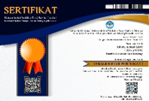HIDROLISIS POLISAKARIDA XILAN JERAMI MENGGUNAKAN LARUTAN ASAM KUATUNTUK BAHAN DASAR PRODUKSI BIOETANOL
DOI:
https://doi.org/10.35799/jis.18.2.2018.20901Abstract
HIDROLISIS POLISAKARIDA XILAN JERAMI MENGGUNAKAN LARUTAN ASAM KUAT UNTUK BAHAN DASAR PRODUKSI BIOETANOL
Â
ABSTRAK
Hidrolisis merupakan proses pemecahan polisakarida (gula kompleks) menjadi polimer yang lebih sederhana, mengingat syarat utama dari proses fermentasi untuk produksi bioetanol adalah gula monomer atau dimer. Polisakarida yang digunakan yakni hasil pretreatment dan ekstraksi jerami. Penggunaan cara kimiawi pada proses hidrolisis ini bertujuan untuk mendapatkan hasil yang optimum dengan waktu yang singkat. Metode penelitian yang digunakan adalah hidrolisis asam dengan membandingkan dua jenis larutan asam kuat yaitu asam sulfat (H2SO4) dan asam klorida (HCl) dengan konsentrasi masig-masing sebesar 0.5 N. Hidrolisis dilakukan dalam kondisi pada suhu 115 0C selama 60 menit pada tekanan 1 atm. Gula sederhana yang dihasilkan telah diuji dengan uji gula total, dengan hasil bahwa gula pereduksi diketahui dari selisih gula total pada kontrol tanpa perlakuan. Uji gula total dilakukan menggunakan metode Dubois, pengujian ini dilakukan pada hasil optimum dari hidrolisis yaitu asam klorida (HCl). Sampel yang diujikan yaitu, xilan (XI) dan kontrol (-) xilan (k-x). Analisis gula total menghasilkan sebanyak 2.906 mg/L untuk XI, sebanyak 728 mg/L untuk (k-x) dengan hasil bahwa perolehan gula pereduksi sebesar 2.124 mg/L. Selisih hasil gula total yang diperoleh antara perlakuan dan kontrol mengindikasikan bahwa proses hidrolisis berhasil mendapatkan gula pereduksi.
Kata kunci: gula kompleks, hidrolisis asam, gula sederhana, gula pereduksi dan gula total.
Â
HYDROLYSIS OF POLYCOXARIDA XYLANE STRAW USING STRONG ACID ACID SOLUTION FOR BASIC MATERIALS OF BIOETANOL PRODUCTION
Â
ABSTRACT
Hydrolysis is the process of breaking polysaccharides (sugar complexes) into simpler polymers, considering the main requirements of the fermentation process for bioethanol production are monomeric or dimeric sugars. The polysaccharides used are the results of pretreatment and extraction of straw. The use of chemical methods in the hydrolysis process aims to obtain optimum results with a short time. The research method used is acid hydrolysis by comparing two types of strong acid solutions namely sulfuric acid (H2SO4) and hydrochloric acid (HCl) with a concentration of each of 0.5 N. Hydrolysis is carried out under conditions at a temperature of 115 0C for 60 minutes at a pressure of 1 atm. The simple sugar produced was tested with a total sugar test, the result of the reducing sugar was known from the total sugar difference in the control without treatment. The total sugar test was carried out using the Dubois method, this test was carried out on the optimum results of hydrolysis, namely hydrochloric acid (HCl). The sample tested were, xylan (XI) and control (-) xylan (k-x). Analysis of total sugar yielded as much as 2,906 mg / L for XI, as much as 728 mg / L for (k-x) the result of the acquisition of reducing sugars was 2,124 mg / L. The difference of the result total sugar produced between treatment and control indicates that the hydrolysis process succeeded in obtaining reducing sugars.
Keywords: complex sugar, acid hydrolysis, simple sugar, reducing sugar and total sugarReferences
Aniriani, G.W., A. Meryandini dan Yopi. 2014. Hidrolisis Xilan Bagas Menggunakan Xilanase Bacillus subtilis 28 dan Karakterisasi Enzimnya. Jurnal Biologi Indonesia. 11(1): 1-9.
Delmer, D.P. and C.H. Haigler. 2002. The regulation of metabolic flux to cellulose, a major sink for carbon in plants. Metab. Eng. 4:22-28.
Dubois, M., K.A. Gilles, J.K. Hamilton, P.A. Rebers and F. Smith. 1956. Colorimetric method for determination of sugars and related substances. Division of Biochemistry, University of Minnesota, St. Paul, Min. Vol.28, no. 3.
Feller , R.L., S.B. Lee and J. Bogaard. 1986. The kinetic of cellulose deterioration. Advances in Chemistry, ACS series. 212:329-347.
Gray, K.A.,L. Zhao and M. Emptage. 2006. Bioethanol. Elsivier (Curent Opinion in Chemical Biology). 10: 141-146.
Hayuningtyas, S.K. et al. 2014. Produksi Bioetanol dari Jerami (Oryza sativa) melalui Hidrolisis Asam dan Fermentasi dengan Saccharomyces cereviceae. Bioteknologi 11 (1): 1-4. ISSN: 0216-6887, EISSN: 2301-8658, DOI: 10.13057.
Harry, W.L. and J.M. Christoper. 1989. Experimental Organic Chemistry: Principles and Practice. Wiley Blackwell. Pp. 159 – 173. ISBN 978-0-632-02017-1.
Iranmahboob, J., F. Nadim and S. Monemi. 2002. Optimizing acid-hydrlysis: a critical step for production of ethanol from mixed wood chips. Biomass and Bioenergy, 22: 401 – 404.
Lavarack, B.P., G.J. Griffin and D. Rodman. 2002. The acid hydrolysis of sugarcane bagas hemicellulose to produce xylose, arabinose, glucose and other products. Biomass Bioenergy.,23, 367-380.
Miller, G.L. 1959. Use of dinitrosalycilic acid reagent for determination of reducing sugar. Anal Chem (31):426-428.
Mosier, N. C. Wyman, B. Dale, R. Elander, Y.Y. Lee, M. Holtzapple and M. Ladisch. 2005. Features of promising technologies for pretreatment of lignocellulosic biomass. Bioresource Technol., 96, 673-686.
Prakash, P., S.K. Jayalaksmi and B. Prakash. 2012. Production of alkaliphilic, halotolerent, thermostable cellulosefree xylanase by Bacillus halodurans PPKS-2 using agro waste:single step purification and characterization. World J Microbiol Biotechnol (2012) 28:183–192.
Reginaldo, dkk. 2007. Structure, organization, and functions of cellulose synthase complexes in higher plants. Biotechnology Researcher Center, USA.
Riyanti, E.I. 2008. Biomassa sebagai bahan baku bioethanol. Jurnal Litbang Pertanian, 28(3).
Sun, Y., and J. Cheng. 2002. Hydrolysis of lignocellulosic materials for ethanol production: a review. Bioresource Technol., 83, 1-11.
Taherzadeh, M.J. and K. Karimi. 2007. Enzymes-based hydrolysis processes for ethanol from lignocellulosic materials: a review. Bioresources 2(4), 707-738.
Vogel, A.R., B.S. Tatchell, A.J. Hannaford, and P.W.G. Smith. Vogel’s Textbook of Practical Organic Chemistry. 2013. ISBN 0-582-46236-3.







